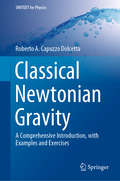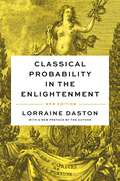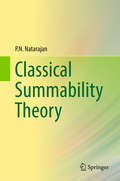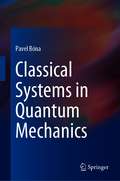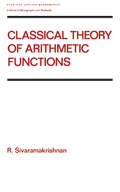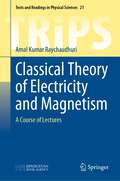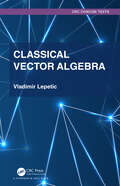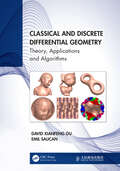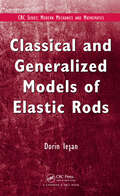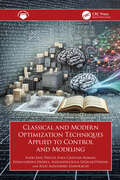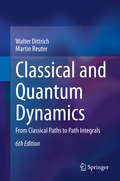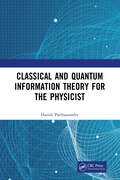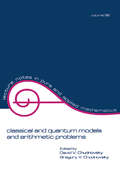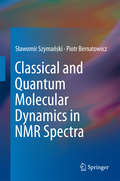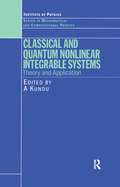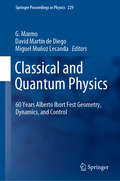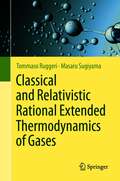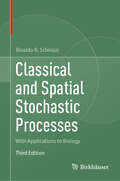- Table View
- List View
Classical Mirror Symmetry (SpringerBriefs In Mathematical Physics #29)
by Masao JinzenjiThis book furnishes a brief introduction to classical mirror symmetry, a term that denotes the process of computing Gromov–Witten invariants of a Calabi–Yau threefold by using the Picard–Fuchs differential equation of period integrals of its mirror Calabi–Yau threefold. The book concentrates on the best-known example, the quintic hypersurface in 4-dimensional projective space, and its mirror manifold.First, there is a brief review of the process of discovery of mirror symmetry and the striking result proposed in the celebrated paper by Candelas and his collaborators. Next, some elementary results of complex manifolds and Chern classes needed for study of mirror symmetry are explained. Then the topological sigma models, the A-model and the B-model, are introduced. The classical mirror symmetry hypothesis is explained as the equivalence between the correlation function of the A-model of a quintic hyper-surface and that of the B-model of its mirror manifold.On the B-model side, the process of construction of a pair of mirror Calabi–Yau threefold using toric geometry is briefly explained. Also given are detailed explanations of the derivation of the Picard–Fuchs differential equation of the period integrals and on the process of deriving the instanton expansion of the A-model Yukawa coupling based on the mirror symmetry hypothesis.On the A-model side, the moduli space of degree d quasimaps from CP^1 with two marked points to CP^4 is introduced, with reconstruction of the period integrals used in the B-model side as generating functions of the intersection numbers of the moduli space. Lastly, a mathematical justification for the process of the B-model computation from the point of view of the geometry of the moduli space of quasimaps is given.The style of description is between that of mathematics and physics, with the assumption that readers have standard graduate student backgrounds in both disciplines.
Classical Newtonian Gravity: A Comprehensive Introduction, with Examples and Exercises (UNITEXT for Physics)
by Roberto A. Capuzzo DolcettaThis textbook offers a readily comprehensible introduction to classical Newtonian gravitation, which is fundamental for an understanding of classical mechanics and is particularly relevant to Astrophysics. The opening chapter recalls essential elements of vectorial calculus, especially to provide the formalism used in subsequent chapters. In chapter two Classical Newtonian gravity theory for one point mass and for a generic number N of point masses is then presented and discussed. The theory for point masses is naturally extended to the continuous case. The third chapter addresses the paradigmatic case of spherical symmetry in the mass density distribution (central force), with introduction of the useful tool of qualitative treatment of motion. Subsequent chapters discuss the general case of non-symmetric mass density distribution and develop classical potential theory, with elements of harmonic theory, which is essential to understand the potential development in series of the gravitational potential, the subject of the fourth chapter. Finally, in the last chapter the specific case of motion of a satellite around the earth is considered. Examples and exercises are presented throughout the book to clarify aspects of the theory. The book is aimed at those who wish to progress further beyond an initial bachelor degree, onward to a master degree, and a PhD. It is also a valuable resource for postgraduates and active researchers in the field.
Classical Probability in the Enlightenment, New Edition
by Lorraine DastonAn award-winning history of the Enlightenment quest to devise a mathematical model of rationalityWhat did it mean to be reasonable in the Age of Reason? Enlightenment mathematicians such as Blaise Pascal, Jakob Bernoulli, and Pierre Simon Laplace sought to answer this question, laboring over a theory of rational decision, action, and belief under conditions of uncertainty. Lorraine Daston brings to life their debates and philosophical arguments, charting the development and application of probability theory by some of the greatest thinkers of the age. Now with an incisive new preface, Classical Probability in the Enlightenment traces the emergence of new kind of mathematics designed to turn good sense into a reasonable calculus.
Classical Relaxation Phenomenology
by Ian M. HodgeThis book serves as a self-contained reference source for engineers, materials scientists, and physicists with an interest in relaxation phenomena. It is made accessible to students and those new to the field by the inclusion of both elementary and advanced math techniques, as well as chapter opening summaries that cover relevant background information and enhance the book's pedagogical value. These summaries cover a wide gamut from elementary to advanced topics.The book is divided into three parts. The opening part, on mathematics, presents the core techniques and approaches. Parts II and III then apply the mathematics to electrical relaxation and structural relaxation, respectively. Part II discusses relaxation of polarization at both constant electric field (dielectric relaxation) and constant displacement (conductivity relaxation), topics that are not often discussed together. Part III primarily discusses enthalpy relaxation of amorphous materials within and below the glass transition temperature range. It takes a practical approach inspired by applied mathematics in which detailed rigorous proofs are eschewed in favor of describing practical tools that are useful to scientists and engineers. Derivations are however given when these provide physical insight and/or connections to other material.A self-contained reference on relaxation phenomenaDetails both the mathematical basis and applicationsFor engineers, materials scientists, and physicists
Classical Summability Theory
by P. N. NatarajanThis book presents results about certain summability methods, such as the Abel method, the Norlund method, the Weighted mean method, the Euler method and the Natarajan method, which have not appeared in many standard books. It proves a few results on the Cauchy multiplication of certain summable series and some product theorems. It also proves a number of Steinhaus type theorems. In addition, it introduces a new definition of convergence of a double sequence and double series and proves the Silverman-Toeplitz theorem for four-dimensional infinite matrices, as well as Schur's and Steinhaus theorems for four-dimensional infinite matrices. The Norlund method, the Weighted mean method and the Natarajan method for double sequences are also discussed in the context of the new definition. Divided into six chapters, the book supplements the material already discussed in G. H. Hardy's Divergent Series. It appeals to young researchers and experienced mathematicians who wish to explore new areas in Summability Theory. .
Classical Systems in Quantum Mechanics
by Pavel BónaThis book investigates two possibilities for describing classical-mechanical physical systems along with their Hamiltonian dynamics in the framework of quantum mechanics.The first possibility consists in exploiting the geometrical properties of the set of quantum pure states of "microsystems" and of the Lie groups characterizing the specific classical system. The second approach is to consider quantal systems of a large number of interacting subsystems – i.e. macrosystems, so as to study the quantum mechanics of an infinite number of degrees of freedom and to look for the behaviour of their collective variables. The final chapter contains some solvable models of “quantum measurement" describing dynamical transitions from "microsystems" to "macrosystems".
Classical Theory of Arithmetic Functions (Chapman And Hall/crc Pure And Applied Mathematics Ser. #126)
by R SivaramakrishnanThis volume focuses on the classical theory of number-theoretic functions emphasizing algebraic and multiplicative techniques. It contains many structure theorems basic to the study of arithmetic functions, including several previously unpublished proofs. The author is head of the Dept. of Mathemati
Classical Theory of Electricity and Magnetism: A Course of Lectures (Texts and Readings in Physical Sciences #21)
by Amal Kumar RaychaudhuriThis book examines the topics of magnetohydrodynamics and plasma oscillations, in addition to the standard topics discussed to cover courses in electromagnestism, electrodynamics, and fundamentals of physics, to name a few. This textbook on electricity and magnetism is primarily targeted at graduate students of physics. The undergraduate students of physics also find the treatment of the subject useful. The treatment of the special theory of relativity clearly emphasises the Lorentz covariance of Maxwell's equations. The rather abstruse topic of radiation reaction is covered at an elementary level, and the Wheeler–Feynman absorber theory has been dwelt upon briefly in the book.
Classical Vector Algebra (Textbooks in Mathematics)
by Vladimir LepeticEvery physicist, engineer, and certainly a mathematician, would undoubtedly agree that vector algebra is a part of basic mathematical instruments packed in their toolbox. Classical Vector Algebra should be viewed as a prerequisite, an introduction, for other mathematical courses dealing with vectors, following typical form and appropriate rigor of more advanced mathematics texts. Vector algebra discussed in this book briefly addresses vectors in general 3-dimensional Euclidian space, and then, in more detail, looks at vectors in Cartesian 3 space. These vectors are easier to visualize and their operational techniques are relatively simple, but they are necessary for the study of Vector Analysis. In addition, this book could also serve as a good way to build up intuitive knowledge for more abstract structures of -dimensional vector spaces. Definitions, theorems, proofs, corollaries, examples, and so on are not useless formalism, even in an introductory treatise -- they are the way mathematical thinking has to be structured. In other words, "introduction" and "rigor" are not mutually exclusive. The material in this book is neither difficult nor easy. The text is a serious exposition of a part of mathematics students need to master in order to be proficient in their field. In addition to the detailed outline of the theory, the book contains literally hundreds of corresponding examples/exercises.
Classical and Discrete Differential Geometry: Theory, Applications and Algorithms
by David Xianfeng Gu Emil SaucanThis book introduces differential geometry and cutting-edge findings from the discipline by incorporating both classical approaches and modern discrete differential geometry across all facets and applications, including graphics and imaging, physics and networks. With curvature as the centerpiece, the authors present the development of differential geometry, from curves to surfaces, thence to higher dimensional manifolds; and from smooth structures to metric spaces, weighted manifolds and complexes, and to images, meshes and networks. The first part of the book is a differential geometric study of curves and surfaces in the Euclidean space, enhanced while the second part deals with higher dimensional manifolds centering on curvature by exploring the various ways of extending it to higher dimensional objects and more general structures and how to return to lower dimensional constructs. The third part focuses on computational algorithms in algebraic topology and conformal geometry, applicable for surface parameterization, shape registration and structured mesh generation. The volume will be a useful reference for students of mathematics and computer science, as well as researchers and engineering professionals who are interested in graphics and imaging, complex networks, differential geometry and curvature.
Classical and Fuzzy Concepts in Mathematical Logic and Applications, Professional Version
by Mircea S. Reghis Eugene RoventaClassical and Fuzzy Concepts in Mathematical Logic and Applications provides a broad, thorough coverage of the fundamentals of two-valued logic, multivalued logic, and fuzzy logic.Exploring the parallels between classical and fuzzy mathematical logic, the book examines the use of logic in computer science, addresses questions in automatic deduction, and describes efficient computer implementation of proof techniques.Specific issues discussed include:Propositional and predicate logicLogic networksLogic programmingProof of correctnessSemanticsSyntaxCompletenesssNon-contradictionTheorems of Herbrand and KalmanThe authors consider that the teaching of logic for computer science is biased by the absence of motivations, comments, relevant and convincing examples, graphic aids, and the use of color to distinguish language and metalanguage. Classical and Fuzzy Concepts in Mathematical Logic and Applications discusses how the presence of these facts trigger a stirring, decisive insight into the understanding process. This view shapes this work, reflecting the authors' subjective balance between the scientific and pedagogic components of the textbook.Usually, problems in logic lack relevance, creating a gap between classroom learning and applications to real-life problems. The book includes a variety of application-oriented problems at the end of almost every section, including programming problems in PROLOG III. With the possibility of carrying out proofs with PROLOG III and other software packages, readers will gain a first-hand experience and thus a deeper understanding of the idea of formal proof.
Classical and Generalized Models of Elastic Rods (Modern Mechanics and Mathematics)
by D. IesanReflecting new developments in the study of Saint-Venant's problem, Classical and Generalized Models of Elastic Rods focuses on the deformation of elastic cylinders for three models of continuum: classical elastic continuum, Cosserat elastic body, and porous elastic material. The author presents a method to construct Saint-Venant's solutions, minim
Classical and Modern Optimization Techniques Applied to Control and Modeling
by Radu-Emil Precup Raul-Cristian Roman Elena-Lorena Hedrea Alexandra-Iulia Szedlak-Stinean Iuliu Alexandru ZamfiracheThe book presents a detailed and unified treatment of the theory and applications of optimization applied to control and modeling, focusing on nature-inspired optimization algorithms to optimally tune the parameters of linear and nonlinear controllers and models, with emphasis on tower crane systems and other representative applications.Classical and Modern Optimization Techniques Applied to Control and Modeling combines classical and modern approaches to optimization, based on the authors’ experience in the field, and presents in a unified structure the essential aspects of optimization in control and modeling from a control engineer’s point of view. It covers linear and nonlinear controllers, and neural networks based on reinforcement learning are considered and analyzed because of the need to reduce the complexity of the controllers and their design so that they can be practical to implement as low-cost automation solutions. The chapters are designed to quickly make the concepts of optimization, control, reinforcement learning, and neural networks understandable to readers with limited experience.This book is intended for a broad audience, including undergraduate and graduate students, engineers (designers, practitioners, and researchers), and anyone facing challenging control problems.
Classical and Multilinear Harmonic Analysis
by Camil Muscalu Wilhelm SchlagThis two-volume text in harmonic analysis introduces a wealth of analytical results and techniques. It is largely self-contained and useful to graduates and researchers in pure and applied analysis. Numerous exercises and problems make the text suitable for self-study and the classroom alike. The first volume starts with classical one-dimensional topics: Fourier series; harmonic functions; Hilbert transform. Then the higher-dimensional Caldern–Zygmund and Littlewood–Paley theories are developed. Probabilistic methods and their applications are discussed, as are applications of harmonic analysis to partial differential equations. The volume concludes with an introduction to the Weyl calculus. The second volume goes beyond the classical to the highly contemporary and focuses on multilinear aspects of harmonic analysis: the bilinear Hilbert transform; Coifman–Meyer theory; Carleson's resolution of the Lusin conjecture; Caldern's commutators and the Cauchy integral on Lipschitz curves. The material in this volume has not previously appeared together in book form.
Classical and Quantum Dynamics: From Classical Paths to Path Integrals (Graduate Texts In Physics Ser.)
by Martin Reuter Walter DittrichGraduate students seeking to become familiar with advanced computational strategies in classical and quantum dynamics will find in this book both the fundamentals of a standard course and a detailed treatment of the time-dependent oscillator, Chern-Simons mechanics, the Maslov anomaly and the Berry phase, to name just a few topics. Well-chosen and detailed examples illustrate perturbation theory, canonical transformations and the action principle, and demonstrate the usage of path integrals. The sixth edition has been enlarged to include the Heisenberg-Euler Lagrangian, Schwinger’s source theory treatment of the low-energy π-ρ-N physics and general relativity, where Riemann’s (Einstein’s) ideas on space and time and their philosophical implications are discussed.
Classical and Quantum Dynamics: From Classical Paths to Path Integrals (Graduate Texts in Physics)
by Martin Reuter Walter DittrichGraduate students who want to become familiar with advanced computational strategies in classical and quantum dynamics will find here both the fundamentals of a standard course and a detailed treatment of the time-dependent oscillator, Chern-Simons mechanics, the Maslov anomaly and the Berry phase, to name a few. Well-chosen and detailed examples illustrate the perturbation theory, canonical transformations, the action principle and demonstrate the usage of path integrals. This new edition has been revised and enlarged with chapters on quantum electrodynamics, high energy physics, Green's functions and strong interaction. "This book is a brilliant exposition of dynamical systems covering the essential aspects and written in an elegant manner. The book is written in modern language of mathematics and will ideally cater to the requirements of graduate and first year Ph. D. students. . . a wonderful introduction to any student who wants to do research in any branch of theoretical Physics. " (Indian Journal of Physics)
Classical and Quantum Dynamics: From Classical Paths to Path Integrals (Graduate Texts in Physics)
by Martin Reuter Walter DittrichGraduate students who want to become familiar with advanced computational strategies in classical and quantum dynamics will find here both the fundamentals of a standard course and a detailed treatment of the time-dependent oscillator, Chern-Simons mechanics, the Maslov anomaly and the Berry phase, to name a few. Well-chosen and detailed examples illustrate the perturbation theory, canonical transformations, the action principle and demonstrate the usage of path integrals. This new edition has been revised and enlarged with chapters on quantum electrodynamics, high energy physics, Green's functions and strong interaction. "This book is a brilliant exposition of dynamical systems covering the essential aspects and written in an elegant manner. The book is written in modern language of mathematics and will ideally cater to the requirements of graduate and first year Ph. D. students. . . a wonderful introduction to any student who wants to do research in any branch of theoretical Physics. " (Indian Journal of Physics)
Classical and Quantum Information Theory for the Physicist
by Harish ParthasarathyThis book deals with certain important problems in Classical and Quantum Information Theory Quantum Information Theory, A Selection of Matrix Inequalities Stochastic Filtering Theory Applied to Electromagnetic Fields and Strings Wigner-distributions in Quantum Mechanics Quantization of Classical Field Theories Statistical Signal Processing Quantum Field Theory, Quantum Statistics, Gravity, Stochastic Fields and Information Problems in Information Theory It will be very helpful for students of Undergraduate and Postgraduate Courses in Electronics, Communication and Signal Processing. Print edition not for sale in South Asia (India, Sri Lanka, Nepal, Bangladesh, Pakistan or Bhutan).
Classical and Quantum Models and Arithmetic Problems
by ChudnovskyHere is an unsurpassed resource-important accounts of a variety of dynamic systems topicsrelated to number theory. Twelve distinguished mathematicians present a rare complete analyticsolution of a geodesic quantum problem on a negatively curved surface ... and explicitdetermination of modular function growth near a real point .. . applications of number theoryto dynamical systems and applications of mathematical physics to number theory . ..tributes to the often-unheralded pioneers in the field ... an examination of completely integrableand exactly solvable physical models .. . and much more!Classical and Quantum Models and Arithmetic Problems is certainly a major source of information,advancing the studies of number theorists, algebraists, and mathematical physicistsinterested in complex mathematical properties of quantum field theory, statistical mechanics,and dynamic systems. Moreover, the volume is a superior source of supplementary readingfor graduate-level courses in dynamic systems and application of number theory .
Classical and Quantum Molecular Dynamics in NMR Spectra
by Sławomir Szymański Piotr BernatowiczThe book provides a detailed account of how condensed-phase molecular dynamics are reflected in the line shapes of NMR spectra. The theories establishing connections between random, time-dependent molecular processes and lineshape effects are exposed in depth. Special emphasis is placed on the theoretical aspects, involving in particular intermolecular processes in solution, and molecular symmetry issues. The Liouville super-operator formalism is briefly introduced and used wherever it is beneficial for the transparency of presentation. The proposed formal descriptions of the discussed problems are sufficiently detailed to be implemented on a computer. Practical applications of the theory in solid- and liquid-phase studies are illustrated with appropriate experimental examples, exposing the potential of the lineshape method in elucidating molecular dynamics NMR-observable molecular phenomena where quantization of the spatial nuclear degrees of freedom is crucial are addressed in the last part of the book. As an introduction to this exciting research field, selected aspects of the quantum mechanics of isolated systems undergoing rotational tunnelling are reviewed, together with some basic information about quantum systems interacting with their condensed environment. The quantum theory of rate processes evidenced in the NMR lineshapes of molecular rotors is presented, and illustrated with appropriate experimental examples from both solid- and liquid-phase spectra. In this context, the everlasting problem of the quantum-to-classical transition is discussed at a quantitative level. The book will be suitable for graduate students and new and practising researchers using NMR techniques.
Classical and Quantum Nonlinear Integrable Systems: Theory and Application
by A KunduCovering both classical and quantum models, nonlinear integrable systems are of considerable theoretical and practical interest, with applications over a wide range of topics, including water waves, pin models, nonlinear optics, correlated electron systems, plasma physics, and reaction-diffusion processes. Comprising one part on classical theories
Classical and Quantum Physics: 60 Years Alberto Ibort Fest Geometry, Dynamics, and Control (Springer Proceedings in Physics #229)
by G. Marmo David Martín de Diego Miguel Muñoz LecandaThis proceedings is based on the interdisciplinary workshop held in Madrid, 5-9 March 2018, dedicated to Alberto Ibort on his 60th birthday. Alberto has great and significantly contributed to many fields of mathematics and physics, always with highly original and innovative ideas.Most of Albertos’s scientific activity has been motivated by geometric ideas, concepts and tools that are deeply related to the framework of classical dynamics and quantum mechanics.Let us mention some of the fields of expertise of Alberto Ibort:Geometric Mechanics; Constrained Systems; Variational Principles; Multisymplectic structures for field theories; Super manifolds; Inverse problem for Bosonic and Fermionic systems; Quantum Groups, Integrable systems, BRST Symmetries; Implicit differential equations; Yang-Mills Theories; BiHamiltonian Systems; Topology Change and Quantum Boundary Conditions; Classical and Quantum Control; Orthogonal Polynomials; Quantum Field Theory and Noncommutative Spaces; Classical and Quantum Tomography; Quantum Mechanics on phase space; Wigner-Weyl formalism; Lie-Jordan Algebras, Classical and Quantum; Quantum-to-Classical transition; Contraction of Associative Algebras; contact geometry, among many others.In each contribution, one may find not only technical novelties but also completely new way of looking at the considered problems. Even an experienced reader, reading Alberto's contributions on his field of expertise, will find new perspectives on the considered topic.His enthusiasm is happily contagious, for this reason he has had, and still has, very bright students wishing to elaborate their PhD thesis under his guidance.What is more impressive, is the broad list of rather different topics on which he has contributed.
Classical and Relativistic Rational Extended Thermodynamics of Gases
by Tommaso Ruggeri Masaru SugiyamaRational extended thermodynamics (RET) is the theory that is applicable to nonequilibrium phenomena out of local equilibrium. It is expressed by the hyperbolic system of field equations with local constitutive equations and is strictly related to the kinetic theory with the closure method of the hierarchies of moment equations. The book intends to present, in a systematic way, new results obtained by RET of gases in both classical and relativistic cases, and it is a natural continuation of the book "Rational Extended Thermodynamics beyond the Monatomic Gas" by the same authors published in 2015. However, this book addresses much wider topics than those of the previous book. Its contents are as follows: RET of rarefied monatomic gases and of polyatomic gases; a simplified RET theory with 6 fields being valid far from equilibrium; RET where both molecular rotational and vibrational modes exist; mixture of gases with multi-temperature. The theory is applied to several typical topics (sound waves, shock waves, etc.) and is compared with experimental data. From a mathematical point of view, RET can be regarded as a theory of hyperbolic symmetric systems, of which it is possible to conduct a qualitative analysis. The book represents a valuable resource for applied mathematicians, physicists, and engineers, offering powerful models for many potential applications such as reentering satellites into the atmosphere, semiconductors, and nanoscale phenomena.
Classical and Spatial Stochastic Processes: With Applications to Biology
by Rinaldo B. SchinaziThe revised and expanded edition of this textbook presents the concepts and applications of random processes with the same illuminating simplicity as its first edition, but with the notable addition of substantial modern material on biological modeling. While still treating many important problems in fields such as engineering and mathematical physics, the book also focuses on the highly relevant topics of cancerous mutations, influenza evolution, drug resistance, and immune response. The models used elegantly apply various classical stochastic models presented earlier in the text, and exercises are included throughout to reinforce essential concepts. The second edition of Classical and Spatial Stochastic Processes is suitable as a textbook for courses in stochastic processes at the advanced-undergraduate and graduate levels, or as a self-study resource for researchers and practitioners in mathematics, engineering, physics, and mathematical biology. Reviews of the first edition: An appetizing textbook for a first course in stochastic processes. It guides the reader in a very clever manner from classical ideas to some of the most interesting modern results. . . . All essential facts are presented with clear proofs, illustrated by beautiful examples. . . . The book is well organized, has informative chapter summaries, and presents interesting exercises. The clear proofs are concentrated at the ends of the chapters making it easy to find the results. The style is a good balance of mathematical rigorosity and user-friendly explanation. --Biometric Journal This small book is well-written and well-organized. . . . Only simple results are treated . . . but at the same time many ideas needed for more complicated cases are hidden and in fact very close. The second part is a really elementary introduction to the area of spatial processes. . . . All sections are easily readable and it is rather tentative for the reviewer to learn them more deeply by organizing a course based on this book. The reader can be really surprised seeing how simple the lectures on these complicated topics can be. At the same time such important questions as phase transitions and their properties for some models and the estimates for certain critical values are discussed rigorously. . . . This is indeed a first course on stochastic processes and also a masterful introduction to some modern chapters of the theory. --Zentralblatt Math
Classical and Spatial Stochastic Processes: With Applications to Biology
by Rinaldo B. SchinaziThis textbook provides an accessible approach to concepts and applications of stochastic processes ideal for a wide range of readers. This revised third edition features an intuitive reorganization with concrete topics introduced early on which are then used to demonstrate more abstract concepts in later chapters. The author has kept chapters short and independent from each other, with several of the longer chapters from previous editions now divided into smaller, more manageable parts. These changes build upon previous editions to allow readers even greater flexibility. The applications that are covered feature active areas of research within biological modeling, such as cancerous mutations, influenza evolution, drug resistance, and immune response. Important problems in fields such as engineering and mathematical physics are presented as well. These topics elegantly apply various classical stochastic models and are motivated throughout with many worked out examples. This third edition of Classical and Spatial Stochastic Processes is suitable as a textbook for a first course in stochastic processes at the upper-undergraduate or graduate level. Because of its accessible approach, it may also be used as a self-study resource for researchers and practitioners in mathematics, engineering, physics, and mathematical biology.

